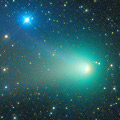
|
Now it is 6.8 mag (Jan. 8, Carlos Labordena). It keeps bright as 7 mag and observable in excellent condition until April. Then it will be fading and will be unobservable in June. In the Southern Hemisphere, it is not observable now. It will be observable in the evening low sky from April to June.
Date(TT) R.A. (2000) Decl. Delta r Elong. m1 Best Time(A, h)
Jan. 14 17 28.13 31 30.6 1.787 1.578 61 6.5 5:38 (254, 37)
Jan. 21 17 25.56 34 47.0 1.696 1.599 67 6.5 5:37 (253, 44)
|
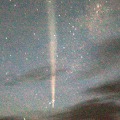
|
New Kreutz sungrazer comet discovered on the ground after 41-year blank since Comet C/1970 K1 (White-Ortiz-Bolelli). It approached nearly to the surface of the Sun on Dec. 16, and reached -4 mag or brighter at best. Then it appeared in the morning sky in the Southern Hemisphere, and it became a great comet with a bright long tail of 30-40 degrees. Now it is 8.5 mag (Jan. 6, Marco Goiato). However, the nucleus of the comet is not visible at all, fainter than 19 mag (Jan. 2, Robert McNaught). Probably the comet itself has already disappeared and only the remnant is visible. It will be fading rapidly after this. It will appear soon also in the Northern Hemisphere.
Date(TT) R.A. (2000) Decl. Delta r Elong. m1 Best Time(A, h)
Jan. 14 4 23.23 -73 35.6 0.532 1.031 79 9.8 20:51 ( 0,-17)
Jan. 21 4 35.47 -54 50.7 0.633 1.192 92 11.2 20:35 ( 0, 1)
|
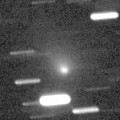
|
Now it is very bright as 9.3 mag (Dec. 22, Juan Jose Gonzalez). It will keep 10 mag until March, but it will be too low to observe. It is already unobservable in the Southern Hemisphere.
Date(TT) R.A. (2000) Decl. Delta r Elong. m1 Best Time(A, h)
Jan. 14 21 2.30 -4 41.9 1.902 1.108 26 10.9 18:38 ( 79, 8)
Jan. 21 21 31.47 -4 33.1 1.879 1.076 25 10.7 18:44 ( 79, 7)
|
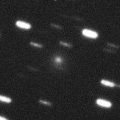
|
It was observed as bright as 13.9 mag in 2011 autumn (Oct. 19, Hidetaka Sato). It is not observable now. In the Northern Hemisphere, it will be observable again in 2012 summer, when it will be fainter than 15 mag. In the Southern Hemisphere, it will never be observable again.
Date(TT) R.A. (2000) Decl. Delta r Elong. m1 Best Time(A, h)
Jan. 14 20 14.32 -9 31.5 2.281 1.352 14 11.8 18:38 ( 82, -4)
Jan. 21 20 36.09 -6 13.2 2.273 1.350 15 11.8 18:44 ( 86, -5)
|

|
Now it is very bright as 10.8 mag (Jan. 1, Marco Goiato). In the Northern Hemisphere, it keeps observable at 11-12 mag in good condition until March, but it will be unobservable in April. In the Southern Hemisphere, it will be low in the evening sky after this.
Date(TT) R.A. (2000) Decl. Delta r Elong. m1 Best Time(A, h)
Jan. 14 0 56.62 4 24.8 1.899 2.009 81 12.2 18:38 ( 34, 55)
Jan. 21 1 9.22 5 25.9 1.971 2.010 77 12.3 18:44 ( 42, 53)
|

|
It brightened up to 17.1 mag in late June in 2011 (June 24, J. F. Hernandez). The condition of this apparition is bad, and it is not observable around the perihelion passage. It will appear in the morning sky at 14 mag in pril in the Southern Hemisphere. It will not be observable until June in the Northern Hemisphere, when the comet will be 15.5 mag.
Date(TT) R.A. (2000) Decl. Delta r Elong. m1 Best Time(A, h)
Jan. 14 19 22.86 -26 22.1 2.567 1.593 6 13.2 5:38 (290,-17)
Jan. 21 19 46.18 -25 49.7 2.575 1.606 7 13.2 5:37 (290,-16)
|
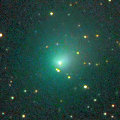
|
It reached up to 9.7 mag with a large bright coma in autumn (Oct. 29, Juan Jose Gonzalez). It will be fading after this. However, an outburst occured and a bright stellar nucleus is visible (Jan. 2, Alfons Diepvens). Now it is 10.9 mag (Jan. 4, Marco Goiato). It keeps high for a while, but it will be getting lower after February. It will be unobservable in late March in the Northern Hemisphere, or late April in the Southern Hemisphere.
Date(TT) R.A. (2000) Decl. Delta r Elong. m1 Best Time(A, h)
Jan. 14 2 55.25 -0 12.7 2.059 2.535 107 13.4 19:22 ( 0, 55)
Jan. 21 2 52.71 -1 51.2 2.233 2.585 99 13.7 18:52 ( 0, 53)
|
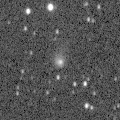
|
Now it is bright as 14.1 mag (Dec. 30, Hidetaka Sato). It keeps bright as 13-14 mag for a long time after this until 2013. It is not observable in the Northern Hemisphere, but it is observable in good condition in the Southern Hemisphere.
Date(TT) R.A. (2000) Decl. Delta r Elong. m1 Best Time(A, h)
Jan. 14 0 50.66 -82 34.1 5.762 5.456 67 13.5 18:38 ( 3,-28)
Jan. 21 1 8.06 -80 47.0 5.753 5.457 67 13.5 18:44 ( 4,-26)
|
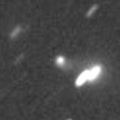
|
It brightened up to 14.1 mag in August and September (Aug. 11, Artyom Novichonok and Vladimir Gerke). Now it is not observable. It will appear in the morning sky at 14 mag at the end of February. Then it will be observable in good condition in the Southern Hemisphere while fading gradually. It will locate somewhat low in the Northern Hemisphere. In 2011, some visual observers reported it was very bright as 10-12 mag.
Date(TT) R.A. (2000) Decl. Delta r Elong. m1 Best Time(A, h)
Jan. 14 18 55.69 -14 24.0 3.317 2.367 12 13.7 5:38 (284, -5)
Jan. 21 19 11.54 -14 41.6 3.317 2.379 14 13.8 5:37 (285, -4)
|
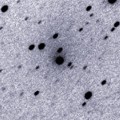
|
Now it is bright as 13.8 mag (Dec. 30, Alan Hale). Strongly condensed, and it seems to be soon after an outburst.
Date(TT) R.A. (2000) Decl. Delta r Elong. m1 Best Time(A, h)
Jan. 14 12 40.08 -12 45.2 6.036 6.261 98 13.9 5:09 ( 0, 42)
Jan. 21 12 40.52 -13 0.5 5.925 6.261 105 13.8 4:42 ( 0, 42)
|
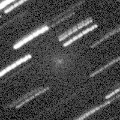
|
First return of a new comet which brightened up to 9.5 mag in a major outburst in 2006. It was recovered on Dec. 17, but much fainter than expected. However, it looks very diffuse, and the total magnitude is bright as 13.5 mag (Dec. 26, Michael Jager). It will approach to the earth down to 0.24 A.U. in January, and will be observable in excellent condition. It may be visible visually.
Date(TT) R.A. (2000) Decl. Delta r Elong. m1 Best Time(A, h)
Jan. 14 1 14.52 9 57.4 0.257 1.008 87 14.2 18:38 ( 29, 62)
Jan. 21 2 3.94 2 23.9 0.240 1.011 89 14.1 18:44 ( 17, 56)
|

|
Big asteroid discovered in 1906. It suddenly showed the cometary activity on Dec. 11, 2010, probably due to an impact of a small object. It was very bright as 11.5 mag visually (Dec. 17, 2010, Juan Jose Gonzalez). Now it is 14.1 mag (Jan. 3, Hidetaka Sato). It has already turned to be stellar.
Date(TT) R.A. (2000) Decl. Delta r Elong. m1 Best Time(A, h)
Jan. 14 15 30.92 -10 46.7 2.845 2.507 60 14.2 5:38 (317, 33)
Jan. 21 15 41.62 -11 31.8 2.759 2.501 64 14.1 5:37 (322, 35)
|
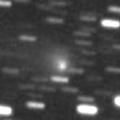
|
Now it is 14.3 mag and visible visually (Oct. 1, Jakub Cerny). It will be observable at 13-14 mag for a long time from 2011 to 2012. However, it will be unobservable temporarily from November to January.
Date(TT) R.A. (2000) Decl. Delta r Elong. m1 Best Time(A, h)
Jan. 14 18 9.91 -14 12.8 6.075 5.180 22 14.3 5:38 (290, 4)
Jan. 21 18 11.43 -14 14.1 6.014 5.173 28 14.2 5:37 (294, 8)
|

|
It was expected to keep 14-15 mag for a long time from 2011 summer to 2012 summer. However, it is lost. It was observed only during two days in 2010 June. So the orbital elements are extremely uncertain. The condition is good in the Southern Hemisphere. But in the Northern Hemisphere, it is not observable until 2012 August.
Date(TT) R.A. (2000) Decl. Delta r Elong. m1 Best Time(A, h)
Jan. 14 21 36.71 -70 32.7 2.788 2.316 52 14.4 18:38 ( 20,-26)
Jan. 21 22 25.22 -69 32.5 2.753 2.308 53 14.3 18:44 ( 20,-24)
|

|
It is not observable at all due to the bad condition in this apparition.
Date(TT) R.A. (2000) Decl. Delta r Elong. m1 Best Time(A, h)
Jan. 14 18 31.96 -18 45.0 2.253 1.336 16 14.5 5:38 (291, -3)
Jan. 21 18 55.34 -18 31.5 2.297 1.391 17 15.1 5:37 (291, -3)
|
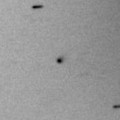
|
It is expected to be bright as 9 mag from 2012 to 2013. Now it is 13.7 mag and visible visually (Jan. 3, Juan Jose Gonzalez). In the Northern Hemisphere, it keeps observable in good condition for a long time until 2012 autumn when the comet brightens up to 10 mag. In the Southern Hemisphere, it is hardly observble before the perihelion passage. But it becomes observable in good condition since 2013 after the perihelion passage.
Date(TT) R.A. (2000) Decl. Delta r Elong. m1 Best Time(A, h)
Jan. 14 15 10.05 45 4.4 4.339 4.455 90 14.7 5:38 (237, 65)
Jan. 21 15 16.88 45 40.5 4.227 4.393 93 14.6 5:37 (233, 68)
|
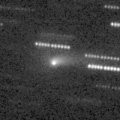
|
It reached up to 11-12 mag in 2011 autumn. Now it is fading, but still bright as 12.8 mag and visible visually (Dec. 3, Marco Goiato). It keeps observable in good condition until May when it becomes fainter than 18 mag. It locates somewhat low in the Southern Hemisphere.
Date(TT) R.A. (2000) Decl. Delta r Elong. m1 Best Time(A, h)
Jan. 14 12 18.78 14 7.7 1.057 1.708 113 14.7 4:48 ( 0, 69)
Jan. 21 12 25.28 15 57.3 1.041 1.749 119 14.9 4:27 ( 0, 71)
|
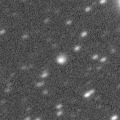
|
Now it is visible visually at 13.6 mag (Nov. 27, Jakub Cerny). It is expected to be 13 mag and will be observable in good condition in 2013. In the Northern Hemisphere, it keeps observable for a long time after this. It is not observable in the Southern Hemisphere.
Date(TT) R.A. (2000) Decl. Delta r Elong. m1 Best Time(A, h)
Jan. 14 22 55.87 51 32.4 6.851 6.831 84 14.7 18:38 (131, 52)
Jan. 21 22 57.09 50 47.7 6.910 6.807 79 14.7 18:44 (130, 47)
|

|
Now it is 15.2 mag (Dec. 11, Toshiyuki Takahashi). It is getting lower in the evening sky. It will be unobservable in late January in the Northern Hemisphere, or in mid March in the Southern Hemisphere. It is expected to be observable at 13 mag for a long time from 2012 summer to 2013 summer. It will be observable in excellent condition in the Southern Hemisphere. But it is not observable at brightest time in the Northern Hemisphere.
Date(TT) R.A. (2000) Decl. Delta r Elong. m1 Best Time(A, h)
Jan. 14 1 4.83 -33 58.1 3.944 3.747 71 15.2 18:38 ( 15, 19)
Jan. 21 1 3.73 -33 41.9 3.982 3.688 65 15.2 18:44 ( 22, 17)
|
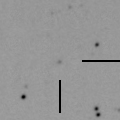
|
It brightened up to 16.6 mag on Oct. 12 (Hidetaka Sato). But it is not observable now. It will keep unobservable until it becomes fainter than 18 mag.
Date(TT) R.A. (2000) Decl. Delta r Elong. m1 Best Time(A, h)
Jan. 14 20 12.17 -20 57.3 2.581 1.612 7 15.2 18:38 ( 72,-11)
Jan. 21 20 33.47 -19 21.4 2.604 1.628 5 15.3 18:44 ( 75,-13)
|
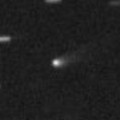
|
Now it is bright as 16.2 mag (Dec. 13, V. Gerke, S. Plaksa, A. Novichonok). Although it was extremely faint as 20.5 mag at the recovery in 2010 autumn, it brightened rapidly. It will keep 15 mag and observable in good condition for a long time from 2012 to 2013. But it locates somewhat low in the Northern Hemisphere in 2013.
Date(TT) R.A. (2000) Decl. Delta r Elong. m1 Best Time(A, h)
Jan. 14 13 25.77 9 20.2 3.213 3.466 96 16.1 5:38 (351, 64)
Jan. 21 13 29.78 9 26.9 3.099 3.448 102 16.0 5:31 ( 0, 64)
|
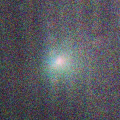
|
It was observed so bright as 9.4 mag in September (Sept. 22, Chris Wyatt). It is still bright as 15.5 mag (Jan. 5, Hidetaka Sato). It will be observable while fading gradually after this. In the Southern Hemisphere, further observations are very hard. Carlos Labordena reported it is very bright as 11.6 mag visually on Dec. 23.
Date(TT) R.A. (2000) Decl. Delta r Elong. m1 Best Time(A, h)
Jan. 14 14 13.57 27 55.3 1.747 2.047 92 16.4 5:38 (293, 74)
Jan. 21 14 2.91 32 57.7 1.690 2.126 102 16.7 5:37 (289, 84)
|
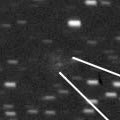
|
It is expected to be a great comet of 0 mag in 2013 spring. Now it is 16.3 mag (Jan. 13, Toshiyuki Takahashi), brightening well. In 2012, it keeps observable until summer while brightening gradually. It locates somewhat low in the Northern Hemisphere.
Date(TT) R.A. (2000) Decl. Delta r Elong. m1 Best Time(A, h)
Jan. 14 16 41.84 -22 2.4 6.602 5.896 41 16.8 5:38 (310, 14)
Jan. 21 16 45.44 -22 17.3 6.449 5.828 47 16.7 5:37 (314, 17)
|
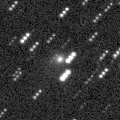
|
Although it has passed the perihelion in 2010 November, it is uxexpectedly bright as 16.4 mag still now (Dec. 17, J. Nicolas). It keeps observable in excellent condition for a while. It will keep 16-17 mag for a while after this.
Date(TT) R.A. (2000) Decl. Delta r Elong. m1 Best Time(A, h)
Jan. 14 5 56.46 8 46.9 4.110 5.001 152 16.8 22:22 ( 0, 64)
Jan. 21 5 49.72 9 44.1 4.215 5.050 144 16.9 21:48 ( 0, 65)
|
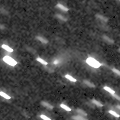
|
Now it is 16.7 mag (Dec. 5, Hidetaka Sato), brighter than the early ephemeris. It keeps observable in good condition for a while after this. It keeps 17 mag until February.
Date(TT) R.A. (2000) Decl. Delta r Elong. m1 Best Time(A, h)
Jan. 14 7 38.29 0 20.8 1.410 2.354 158 17.0 0:09 ( 0, 55)
Jan. 21 7 33.08 0 15.9 1.422 2.365 158 17.0 23:31 ( 0, 55)
|
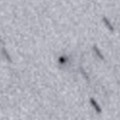
|
Now it is 17.3 mag (Dec. 21, H. Mikuz). It tends to be brightest after the perihelion passage. It is observable in excellent condition in the Northern Hemisphere. It locates somewhat low in the Southern Hemisphere. It will be fainter than 18 mag in March.
Date(TT) R.A. (2000) Decl. Delta r Elong. m1 Best Time(A, h)
Jan. 14 11 21.37 24 59.3 1.876 2.612 129 17.0 3:51 ( 0, 80)
Jan. 21 11 19.65 26 9.9 1.854 2.652 136 17.0 3:22 ( 0, 81)
|
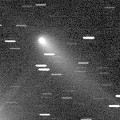
|
First return of a new periodic comet which brightened up to 13 mag in a major outburst in 2005. In this apparition, it brightened up to 12 mag in 2011 summer and autumn. Now it is fading. It has already faded down to 16.8 mag (Dec. 18, Toshiyuki Takahashi). It keeps observable in good condition until February when it fades out down to 17-18 mag. Its fragments have not been observed since early October.
Date(TT) R.A. (2000) Decl. Delta r Elong. m1 Best Time(A, h)
Jan. 14 23 57.68 9 47.0 2.732 2.578 70 17.0 18:38 ( 58, 51)
Jan. 21 0 7.76 10 40.6 2.840 2.603 66 17.2 18:44 ( 65, 47)
|
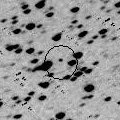
|
Peculiar asteroid moving along a cometary orbit. Now it is 18.4 mag (Oct. 26, Hidetaka Sato). It keeps observable at 18 mag for a long time from 2008 to 2014.
Date(TT) R.A. (2000) Decl. Delta r Elong. m1 Best Time(A, h)
Jan. 14 7 40.06 13 23.8 5.666 6.641 171 17.0 0:10 ( 0, 68)
Jan. 21 7 34.83 14 10.0 5.677 6.648 169 17.1 23:33 ( 0, 69)
|
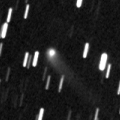
|
Now it is 16.2 mag (Dec. 13, V. Gerke, A. Novichonok). It will be getting lower gradually after this, and will be unobservable in March. It is not observable in the Southern Hemisphere.
Date(TT) R.A. (2000) Decl. Delta r Elong. m1 Best Time(A, h)
Jan. 14 23 9.12 32 51.5 6.049 5.852 73 17.1 18:38 (100, 53)
Jan. 21 23 15.07 32 22.9 6.171 5.886 68 17.2 18:44 (102, 47)
|

|
It brightened up to 13-14 mag and became visible visually from 2007 to 2009. Now it is fading. But it is still bright as 17.6 mag (Dec. 11, Ken-ichi Kadota). In the Northern Hemisphere, it keeps observable in excellent condition until early summer in 2012. In the Southern Hemisphere, it locates extremely low only.
Date(TT) R.A. (2000) Decl. Delta r Elong. m1 Best Time(A, h)
Jan. 14 10 43.70 38 37.6 10.492 11.233 137 17.1 3:13 (180, 86)
Jan. 21 10 40.30 38 59.6 10.472 11.269 142 17.1 2:43 (180, 86)
|
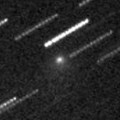
|
Now it is 16.4 mag (Nov. 23, Catalina Sky Survey). It was observed at 17.5 mag in 2011 spring, when the condition was good in the Southern Hemisphere. It will be observable at 17 mag in this winter, when the condition is good in the Northern Hemisphere.
Date(TT) R.A. (2000) Decl. Delta r Elong. m1 Best Time(A, h)
Jan. 14 7 52.16 40 0.3 1.608 2.559 161 17.1 0:24 (180, 85)
Jan. 21 7 13.61 41 34.4 1.674 2.602 155 17.3 23:09 (180, 83)
|
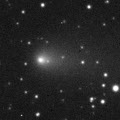
|
It became bright as 12 mag in 2010. Now it is fading. It has already faded down to 16.2 mag (Nov. 14, V. Gerke, A. Novichonok, S. Plaksa).
Date(TT) R.A. (2000) Decl. Delta r Elong. m1 Best Time(A, h)
Jan. 14 1 32.69 3 38.9 3.972 4.088 89 17.1 18:38 ( 18, 57)
Jan. 21 1 35.56 4 13.0 4.097 4.104 83 17.2 18:44 ( 31, 55)
|

|
It passed very near by the earth, within 0.1 A.U., and brightened up to 8.0 mag in the southern sky (Aug. 14, Willian Souza). After appearing in the morning sky in late September, it brightened up to 6.6 mag (Sept. 25, Juan Jose Gonzalez). Now it is fading. It has already faded down to 15.7 mag (Dec. 11, Ken-ichi Kadota).
Date(TT) R.A. (2000) Decl. Delta r Elong. m1 Best Time(A, h)
Jan. 14 14 6.95 -8 1.1 1.724 1.841 80 17.2 5:38 (340, 45)
Jan. 21 14 10.47 -8 4.1 1.705 1.923 86 17.4 5:37 (347, 46)
|
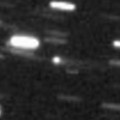
|
Now it is 17.2 mag (Dec. 18, J. F. Hernandez). It keeps observable at 18 mag for a long time until 2013.
Date(TT) R.A. (2000) Decl. Delta r Elong. m1 Best Time(A, h)
Jan. 14 5 4.32 25 42.7 3.077 3.918 144 17.4 21:31 ( 0, 81)
Jan. 21 5 1.99 25 35.8 3.144 3.918 136 17.4 21:01 ( 0, 81)
|
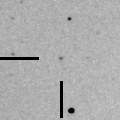
|
It is expected to keep 13 mag and observable in good condition in the Northern Hemisphere for a long time from 2013 to 2014. Now it is 18.3 mag (Nov. 7, Hidetaka Sato). It keeps observable at 17-18 mag in good condition until June.
Date(TT) R.A. (2000) Decl. Delta r Elong. m1 Best Time(A, h)
Jan. 14 11 30.09 -2 1.7 6.431 6.961 118 17.5 4:00 ( 0, 53)
Jan. 21 11 27.66 -1 28.8 6.280 6.915 126 17.4 3:30 ( 0, 53)
|
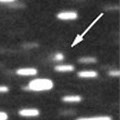
|
It reached up to 15.3 mag in early summer in 2011 (June 19, Toshiyuki Takahashi). Now it is fading. It has already faded down to 17.6 mag (Dec. 28, Hidetaka Sato). It will be fainter than 18 mag in March. I will locate high in the Southern Hemishere, but somewhat low in the Northern Hemisphere after this.
Date(TT) R.A. (2000) Decl. Delta r Elong. m1 Best Time(A, h)
Jan. 14 15 27.53 -15 48.1 2.939 2.584 59 17.5 5:38 (321, 30)
Jan. 21 15 36.95 -16 42.2 2.884 2.612 64 17.5 5:37 (326, 31)
|
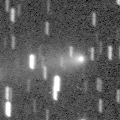
|
It had been fading after the perihelion passage in 2010 October, but it brightened again in outburst on Apr. 5, 2011. It reached up to 14.7 mag in May (May 28, Hidetaka Sato). It has been unobservable since July. But it is appearing in the morning sky now. Now it is 17.3 mag, much brighter than expected (Nov. 26, Hidetaka Sato). It locates low in the Southern Hemisphere. But in the Northern Hemisphere, it keeps observable in good condition after this. It will keep 17 mag for a while.
Date(TT) R.A. (2000) Decl. Delta r Elong. m1 Best Time(A, h)
Jan. 14 13 43.81 15 7.2 3.543 3.751 94 17.7 5:38 (337, 69)
Jan. 21 13 46.55 15 29.1 3.474 3.779 100 17.7 5:37 (352, 70)
|
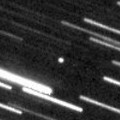
|
Now it is 17.5 mag (Nov. 5, LINEAR). It keeps observable in good condition at 17-18 mag until March. It locates low in the Southern Hemisphere.
Date(TT) R.A. (2000) Decl. Delta r Elong. m1 Best Time(A, h)
Jan. 14 1 45.40 22 20.6 1.392 1.829 99 17.7 18:38 ( 26, 76)
Jan. 21 1 44.56 20 58.4 1.443 1.770 91 17.7 18:44 ( 47, 71)
|
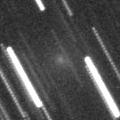
|
Extremely diffuse and hardly detected by CCD images. The nucleus is already fainter than 18 mag (Oct. 15, Jean-Francois Soulier). The comet can be already disintegrated. However, Juan Jose Gonzalez reported it so bright as 9.5 mag visually on Sept. 25. It is observable in good condition in the Southern Hemisphere. It locates extremely low in the Northern Hemisphere. No observations have been reported since October.
Date(TT) R.A. (2000) Decl. Delta r Elong. m1 Best Time(A, h)
Jan. 14 11 17.45 -47 11.7 1.925 2.247 95 17.7 3:47 ( 0, 8)
Jan. 21 11 1.88 -50 2.3 1.950 2.335 100 17.9 3:04 ( 0, 5)
|
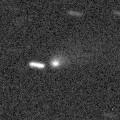
|
It was revealed to be a comet when appearing in the morning sky in early August. It was visible as 13.8 mag and visible visually (Sept. 4, Sandor Szabo). Now it is fading. It has already faded down to 17.6 mag (Dec. 23, G. Hug). In the Northern Hemisphere, it keeps observable in excellent condition for a long time until 2012 summer. But it will be fainter than 18 mag in late January. It is not observable at all in the Southern Hemisphere.
Date(TT) R.A. (2000) Decl. Delta r Elong. m1 Best Time(A, h)
Jan. 14 12 3.28 54 39.1 2.632 3.252 121 17.7 4:33 (180, 70)
Jan. 21 11 59.25 55 37.6 2.643 3.304 124 17.9 4:01 (180, 69)
|
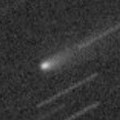
|
Now it is 15.6 mag (Dec. 17, Ken-ichi Kadota), brighter than this ephemeris. Hidetaka Sato reported a small outburst occured in early December. In the Northern Hemisphere, it keeps locating the same altitude in the morning sky. In the Southern Hemisphere, it locates extremely low now, but it will be getting higher gradually. The ephemeris says it will be fainter than 18 mag in late January. But it may keep brighter some more time.
Date(TT) R.A. (2000) Decl. Delta r Elong. m1 Best Time(A, h)
Jan. 14 14 30.27 -32 16.1 1.721 1.638 68 17.8 5:38 (342, 20)
Jan. 21 14 42.66 -33 58.1 1.731 1.710 72 18.0 5:37 (345, 19)
|
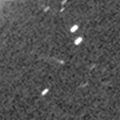
|
Now it is 17.6 mag (Dec. 16, J. Gonzalez). It will be fainter than 18 mag in late January.
Date(TT) R.A. (2000) Decl. Delta r Elong. m1 Best Time(A, h)
Jan. 14 2 56.63 -13 43.8 3.671 3.997 102 17.9 19:24 ( 0, 41)
Jan. 21 2 58.16 -13 9.3 3.760 3.994 96 17.9 18:58 ( 0, 42)
|
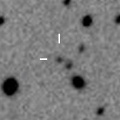
|
Now it is 17.2 mag (Jan. 14, K. Hills). It will brighten up to 13 mag in 2014. In 2012, it is observable at 17.5 mag in good condition in spring.
Date(TT) R.A. (2000) Decl. Delta r Elong. m1 Best Time(A, h)
Jan. 14 11 39.16 13 4.8 3.832 4.438 122 18.0 4:09 ( 0, 68)
Jan. 21 11 38.48 13 23.4 3.731 4.425 129 17.9 3:40 ( 0, 68)
|
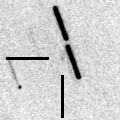
|
It had expected to keep 17 mag for a long time from 2011 summer to 2012 spring and observable in good condition in the Southern Hemisphere. But actually, it has faded down to 20.7 mag (Jan. 16, D. Herald), much fainter than expected by 4 mag.
Date(TT) R.A. (2000) Decl. Delta r Elong. m1 Best Time(A, h)
Jan. 14 10 35.32 -74 20.6 2.080 2.143 80 20.3 3:06 ( 0,-19)
Jan. 21 9 43.93 -73 5.1 2.024 2.180 85 20.3 1:48 ( 0,-18)
|
|
![]()
 41P/Tuttle-Giacobini-Kresak
41P/Tuttle-Giacobini-Kresak C/2011 F1 ( LINEAR )
C/2011 F1 ( LINEAR ) 49P/Arend-Rigaux
49P/Arend-Rigaux C/2010 S1 ( LINEAR )
C/2010 S1 ( LINEAR ) C/2011 R1 ( McNaught )
C/2011 R1 ( McNaught ) 37P/Forbes
37P/Forbes 246P/2010 V2 ( NEAT )
246P/2010 V2 ( NEAT ) C/2011 Q4 ( SWAN )
C/2011 Q4 ( SWAN ) C/2011 L4 ( PanSTARRS )
C/2011 L4 ( PanSTARRS ) C/2010 FB87 ( WISE-Garradd )
C/2010 FB87 ( WISE-Garradd ) P/2011 W2 ( Rinner )
P/2011 W2 ( Rinner ) 164P/Christensen
164P/Christensen 213P/2009 B3 ( Van Ness )
213P/2009 B3 ( Van Ness ) 2008 YB3
2008 YB3 C/2008 FK75 ( Lemmon-Siding Spring )
C/2008 FK75 ( Lemmon-Siding Spring ) C/2005 L3 ( McNaught )
C/2005 L3 ( McNaught ) C/2011 G1 ( McNaught )
C/2011 G1 ( McNaught ) 65P/Gunn
65P/Gunn 45P/Honda-Mrkos-Pajdusakova
45P/Honda-Mrkos-Pajdusakova 244P/2010 Q1 ( Scotti )
244P/2010 Q1 ( Scotti ) C/2011 J2 ( LINEAR )
C/2011 J2 ( LINEAR ) 123P/West-Hartley
123P/West-Hartley 240P/2010 P1 ( NEAT )
240P/2010 P1 ( NEAT ) (3200) Phaethon
(3200) Phaethon C/2011 M1 ( LINEAR )
C/2011 M1 ( LINEAR ) P/2010 JC81 ( WISE )
P/2010 JC81 ( WISE ) C/2011 S2 ( Kowalski )
C/2011 S2 ( Kowalski ) 242P/2010 P3 ( Spahr )
242P/2010 P3 ( Spahr ) 117P/Helin-Roman-Alu 1
117P/Helin-Roman-Alu 1 C/2011 L2 ( McNaught )
C/2011 L2 ( McNaught )![]()









































